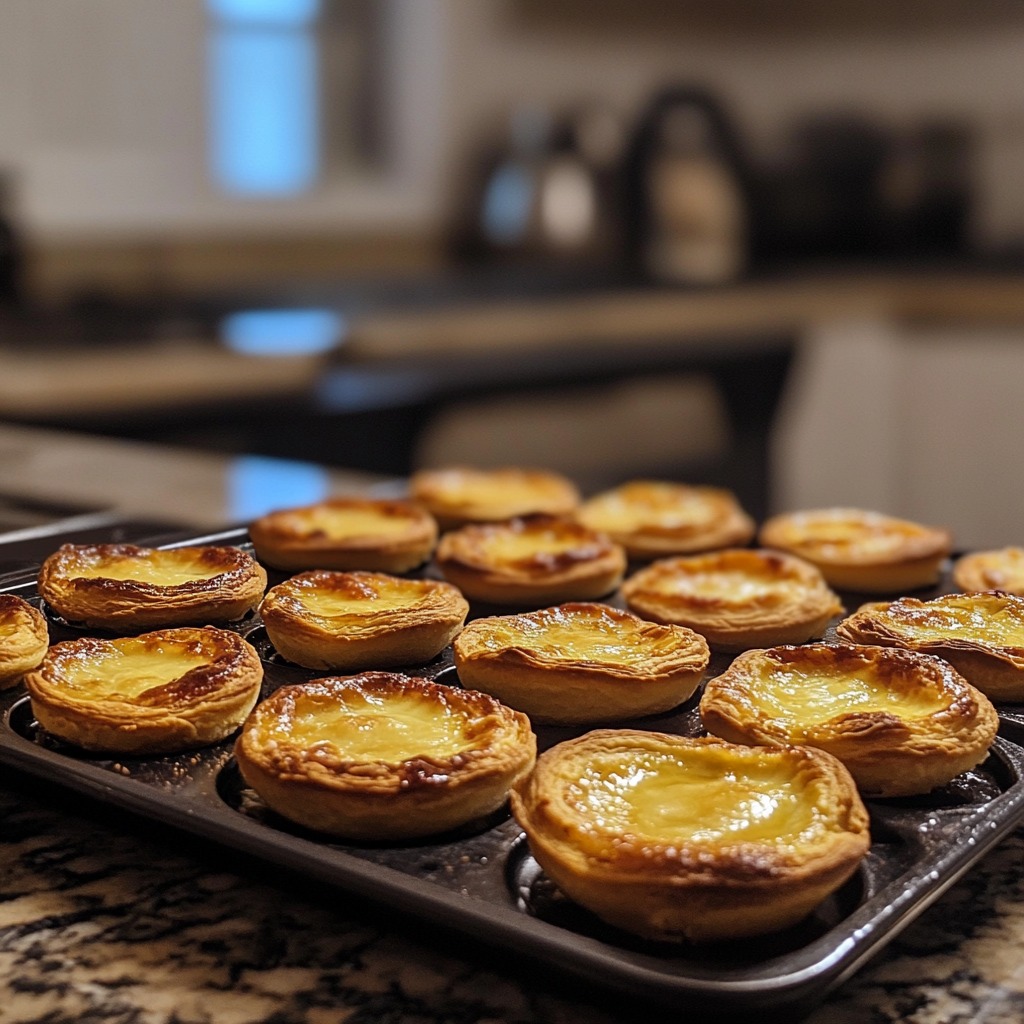Have you ever wondered what it feels like to bite into a piece of heaven? If you haven’t experienced the blissful delight of Pastéis de Nata, you’re in for a treat. These Portuguese custard tarts are a symphony of flavors and textures, and they come with a rich history that makes each bite even more special. Imagine biting through a crispy, flaky pastry shell to reach a luscious, creamy custard center, and then savoring the subtle hints of cinnamon and vanilla. This is the Pastéis de Nata experience.
The origin of Pastéis de Nata dates back to the 18th century in Lisbon, Portugal, where monks at the Jerónimos Monastery created these tarts to use up surplus egg yolks. Fast forward to today, and these iconic tarts have become a beloved dessert not only in Portugal but around the world. Their golden, caramelized tops and creamy interiors make them irresistible.
Making these tarts at home can be a fun adventure. The key is to achieve the perfect balance between the crispiness of the pastry and the silkiness of the custard. Don’t be intimidated by the process; with a bit of practice and patience, you’ll be able to recreate this Portuguese classic in your own kitchen. Your family and friends will be amazed at your baking skills.
So why not embark on this culinary journey with me? I promise, once you taste these tarts fresh out of the oven, you’ll understand why they’ve stood the test of time. They’re perfect for special occasions, as a sweet snack with your afternoon tea, or even as an indulgent breakfast treat.
These Pastéis de Nata are a creamy custard delight with a crispy, flaky pastry shell. Originating from Lisbon, Portugal, these tarts have become a beloved treat worldwide. The combination of rich custard, caramelized tops, and a hint of cinnamon and vanilla make each bite heavenly.
Creating these tarts at home is easier than you think. With just a few key ingredients and some patience, you can achieve the perfect balance of textures and flavors. Serve them fresh out of the oven, and your family and friends will be wowed by your baking prowess.
The history and tradition behind Pastéis de Nata add a special touch to this recipe. Whether you’re making them for a special occasion or as an everyday indulgence, these tarts are sure to become a favorite.
Get ready to impress with this classic Portuguese dessert. Once you try them, you’ll understand why they’ve been adored for centuries.
Exciting Story:
Let me tell you about the time I introduced my family to Pastéis de Nata. It was a sunny Sunday afternoon, and we were hosting a small family gathering. I wanted to surprise everyone with something special, so I decided to make these Portuguese custard tarts. My husband was skeptical at first, thinking they might be too complicated to make, but I was determined to prove him wrong.
As the tarts baked in the oven, the sweet aroma of vanilla and cinnamon filled our home. When I pulled them out, golden and caramelized, everyone gathered around, eagerly waiting for a taste. The first bite was magical. The crispy pastry shell gave way to the creamy, silky custard, and the flavors exploded in our mouths.
My husband couldn’t stop raving about them, and our kids, who usually shy away from anything that isn’t chocolate, were devouring them with big smiles on their faces. It was a moment of pure joy and satisfaction, and those tarts quickly became a staple in our household. Now, every time we have a family gathering, Pastéis de Nata is on the menu.
Why This Pastéis de Nata?
Selling Points:
- Rich History: These tarts have a fascinating origin dating back to 18th century Lisbon, making them a piece of culinary heritage.
- Flavor Combination: The perfect blend of creamy custard, caramelized tops, and a hint of cinnamon and vanilla.
- Texture Perfection: Achieve a crispy, flaky pastry shell with a silky smooth custard interior.
- Impress Your Guests: A show-stopping dessert that’s sure to wow family and friends.
- Versatile Treat: Enjoy them fresh out of the oven, as a dessert, snack, or even an indulgent breakfast.
What You Need For Pastéis de Nata:
- 1 package puff pastry, thawed
- 1 cup whole milk
- 1/2 cup heavy cream
- 1/2 cup granulated sugar
- 1/4 cup all-purpose flour
- 6 large egg yolks
- 1 teaspoon vanilla extract
- 1 teaspoon ground cinnamon
- Powdered sugar for dusting (optional)

How to Make Pastéis de Nata:
- Prepare the Pastry: Preheat your oven to 475°F (245°C). Roll out the puff pastry and cut it into circles to fit your tart tins. Press the pastry into the tins, ensuring it reaches up the sides. Chill in the refrigerator while you prepare the custard.
- Make the Custard: In a medium saucepan, combine the milk, cream, and sugar. Heat over medium heat until the sugar dissolves. In a separate bowl, whisk together the flour and egg yolks until smooth. Gradually add the hot milk mixture to the egg mixture, whisking constantly to prevent curdling. Return the mixture to the saucepan and cook over low heat, stirring constantly, until thickened. Remove from heat and stir in the vanilla extract and ground cinnamon.
- Fill the Tarts: Pour the custard into the prepared pastry shells, filling each about three-quarters full.
- Bake: Bake the tarts for 10-12 minutes, or until the tops are golden and caramelized. Keep an eye on them to avoid over-browning.
- Serve: Allow the tarts to cool slightly before removing them from the tins. Dust with powdered sugar if desired and serve warm.
Tips For Pastéis de Nata:
- Perfect Pastry: Ensure the puff pastry is cold when you press it into the tins. This helps achieve a crisp, flaky texture.
- Avoid Overcooking: Keep a close eye on the tarts while baking to prevent the tops from over-browning. A golden caramelized top is ideal.
Substitutions and Variations:
- Different Ingredients: Swap the whole milk with almond or oat milk for a dairy-free version. Use a gluten-free puff pastry for a gluten-free option.
- Cooking Methods: If you don’t have tart tins, use a muffin tin instead. The tarts will be slightly larger but just as delicious.
- Serving Suggestions: Serve these tarts with a sprinkle of cinnamon or a dollop of whipped cream for added indulgence.
Make a Healthier Version:
- Low Carb: Use a low-carb puff pastry alternative if available.
- Gluten-Free: Opt for gluten-free puff pastry and flour.
- Low Fat: Substitute the heavy cream with a low-fat or plant-based cream option.
Closing For Pastéis de Nata:
And there you have it! These Pastéis de Nata are sure to become a beloved addition to your recipe collection. Don’t forget to let us know how your dish turns out, and consider checking out some of our other recipes. Enjoy these creamy, flaky delights!
Frequently Asked Questions For Pastéis de Nata:
- Can I make these tarts ahead of time?
Yes, you can prepare the pastry and custard in advance and assemble and bake when ready to serve. - How do I achieve a crisp, flaky pastry?
Ensure the puff pastry is cold when you press it into the tins and avoid overworking it. - Can I use a different type of milk?
Yes, almond or oat milk can be used as substitutes for whole milk. - What can I serve with these tarts?
A sprinkle of cinnamon or a dollop of whipped cream pairs beautifully with these tarts. - How long do these tarts last?
These tarts are best enjoyed fresh but can be stored in an airtight container for up to 2 days. - Can I freeze these tarts?
It’s not recommended to freeze as the texture may change. Enjoy them fresh for the best experience. - What makes these tarts unique?
The combination of a crispy pastry shell and creamy custard with a hint of cinnamon and vanilla makes them unique. - Can I use a muffin tin instead of tart tins?
Yes, muffin tins can be used. The tarts will be larger but just as delicious. - How do I prevent the custard from curdling?
Gradually add the hot milk mixture to the egg yolks while whisking constantly to prevent curdling. - Can I make a dairy-free version?
Substitute the whole milk and heavy cream with almond or oat milk for a dairy-free version. - Is there a gluten-free option?
Use gluten-free puff pastry and flour to make these tarts gluten-free. - Can I add other flavors to the custard?
Yes, you can experiment with flavors like citrus zest or almond extract for a unique twist.
I hope this Pastéis de Nata recipe brings a touch of Portuguese charm


